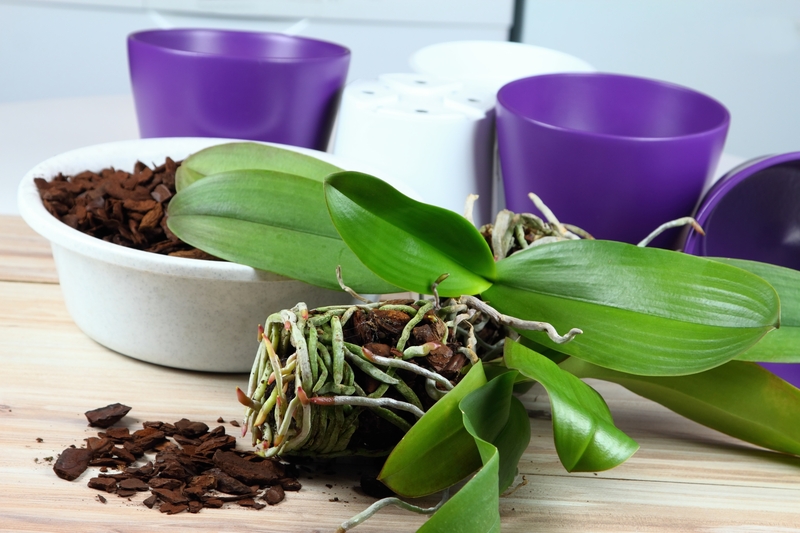Shielding Your Garden from Harsh Weather Conditions
Posted on 20/05/2025
Shielding Your Garden from Harsh Weather Conditions: Best Tips & Proven Strategies
Gardening offers serenity, beauty, and a productive way to spend time outdoors. Yet, every gardener knows that harsh weather conditions can ruin months of dedicated effort in a matter of hours. Whether it's a sudden frost, relentless wind, scorching heat, or heavy downpours, the elements can be cruel. Understanding how to shield your garden from severe weather is essential for both novice and seasoned gardeners alike.
In this comprehensive guide, we'll explore expert tips, time-tested techniques, and innovative solutions to help you protect your outdoor oasis no matter what Mother Nature throws your way. From frost blankets to smart plant selection, discover how to keep your garden thriving year-round.
Why Is Protecting Your Garden from Extreme Weather Important?
Plants are living organisms sensitive to their surroundings. Unprotected exposure to extreme elements may lead to:
- Wilting or scorched leaves from excessive heat or sun exposure
- Root rot and fungal diseases due to overwatering and flooding
- Frost damage resulting in discolored, mushy, or dead plant tissue
- Windburned foliage and broken branches from strong gusts
- Soil erosion and nutrient loss after heavy rains
Shielding a garden from unfavorable weather is no longer optional--it's a necessity if you want to ensure healthy, resilient plants and abundant yields.

Understanding the Types of Harsh Weather Your Garden Faces
To effectively protect your garden from harsh weather conditions, you first need to recognize what you're up against:
- Frost & Freezing Temperatures: Common in late autumn, winter, and early spring.
- Heatwaves & Drought: Can occur during the peak of summer, drying out soil rapidly.
- Heavy Rains & Flooding: Threaten root health and cause soil compaction or erosion.
- Strong Winds & Storms: Capable of uprooting plants or inflicting structural damage.
- Hail: May physically tear and destroy leaves and tender shoots.
Strategies for Shielding Your Garden from Harsh Weather
1. Preparing Your Soil for All Seasons
A strong, healthy garden begins with robust soil. Taking proactive measures not only improves drainage and nutrient absorption but also helps the soil hold moisture during drought or release it in stormy weather.
- Add Compost: Organic matter increases resilience against both droughts and heavy rains.
- Mulch Generously: Apply a 2-4 inch layer around plants. Mulch conserves moisture, regulates temperature, and prevents soil erosion.
- Improve Drainage: For clay soils, integrate sand or perlite. For compacted areas, gently aerate before planting.
2. Mulching: Nature's Protective Blanket
Mulching is one of the most effortless and cost-effective ways to defend against many weather extremes:
- In Winter: Mulch insulates roots and prevents frost heaving.
- In Summer: Mulch keeps soil cool, retains water, and minimizes evaporation.
- During Heavy Rains: A layer of mulch prevents soil compaction and runoff.
Choose between organic mulch (bark, straw, leaf mold) or inorganic options (stones, landscape fabric) to suit your climate and garden needs.
3. Protective Covers: The Garden's First Line of Defense
- Frost Cloths & Row Covers: Lightweight fabrics like frost blankets, horticultural fleece, and even old bed sheets can be draped over vulnerable plants at night to shield from sudden cold snaps or predicted frosts.
- Shade Cloths: Protect delicate plants from scorching midday sun. Use adjustable frames so you can move or angle the shield as necessary.
- Cloche & Bell Jars: Place over individual seedlings or delicate plants to create a mini greenhouse effect, maintaining warmth and humidity.
- Hoop Houses & Greenhouses: For a larger investment, these structures offer year-round protection. They're ideal if your region faces frequent frost, hail, or prolonged cold seasons.
Pro Tip: Remember to ventilate covered plants during the day to prevent overheating, especially during fluctuating temperatures!
4. Wind Barriers and Physical Supports
High winds can uproot plants, snap stems, and desiccate leaves. To protect your garden from damaging winds:
- Install Windbreaks: Use solid fences, trellises, or even living windbreaks such as evergreen hedges or rows of tall grasses.
- Stake Young or Tall Plants: Use bamboo canes, stakes, or tomato cages to secure vulnerable specimens. Secure ties loosely to avoid damaging stems as they grow.
- Create Microclimates: Plant wind-sensitive specimens closer to buildings, fences, or taller companion plants that shield them naturally.
5. Smart Plant Selection: Choose Weather-Resilient Varieties
Not all plants are created equal when it comes to withstanding harsh weather. Selecting robust varieties increases your garden's ability to survive extreme conditions.
- Drought-Tolerant Plants: Lavender, sedum, yarrow, and native prairie flowers are adapted for low-water situations.
- Frost-Hardy Plants: Kale, pansies, carrots, and cabbages endure cold snaps better.
- Wind-Resistant Shrubs: Boxwood, holly, juniper, and spruce are excellent wind buffers.
- Flood-Tolerant Choices: Iris, Joe-Pye weed, marsh marigold, and some ferns handle soggy soils confidently.
When in doubt, prioritize native plants--they're often already adapted to your local climate.
6. Pruning and Maintenance for Weather Resilience
A well-maintained plant is inherently more resilient. Regular pruning keeps your garden healthy and less susceptible to wind or snow damage:
- Remove Dead or Weak Growth: Dead limbs or spindly branches easily snap in strong winds, increasing the risk of disease entry.
- Thin Dense Canopies: Prevents wind tunnels forming and reduces damage from heavy snow or hail.
- Monitor for Pests and Diseases: Weakened plants are more vulnerable during extreme weather.
Specialized Methods for Specific Weather Threats
Protecting Against Frost and Freezes
- Water Before a Freeze: Moist soil holds heat better than dry, offering roots some insulation.
- Feed Sparingly in Fall: Excess nitrogen encourages tender new growth that's frost-prone.
- Build Raised Beds: Soil in raised beds warms faster and drains better, reducing frost hazard.
- Immediate Covering at Night: Always remove covers during the day to allow sunlight in.
Shielding Against Intense Sun and Drought
- Water Early: Watering in the early morning allows soil to soak up moisture before the sun evaporates it.
- Use Drip Irrigation: Delivers water right to the roots, minimizing waste and keeping foliage dry.
- Group Similar Plants: Place plants with similar water and sun needs together for easier, more effective watering.
- Apply White Mulch: Reflects sunlight, reducing soil surface temperature.
Defending Against Heavy Rain, Flooding, and Hail
- Create Swales or Berms: Sculpt soil to direct water away from sensitive areas.
- Install French Drains: These underground tunnels channel water away, preventing standing water.
- Use Floating Row Covers: Special hail netting absorbs impact and protects tender crops.
- Elevate Planting Containers: Placing containers or pots on bricks or stands keeps roots above floodwaters.
Reducing Wind Impact Year-Round
- Temporary Fencing: Easily install windbreak fabric or plastic mesh for protection during storm warnings.
- Companion Planting: Taller, flexible plants like sunflowers can shield shorter, more delicate crops.
Combine these strategies for a layered, holistic approach to garden protection.
What to Do After a Weather Event: Restoring Your Garden
Even with the best preparation, severe weather can sometimes overpower your defenses. Acting swiftly after a major event can help revive your garden:
- Assess and Remove Debris: Quickly clear away broken branches, leaves, and damaged plants.
- Prune and Trim: Cut back torn foliage and stems to prevent disease spread.
- Aerate and Loosen Soil: Heavy rain can compact soil--gently loosen to restore aeration and drainage.
- Feed and Mulch: Follow up stressful conditions with a gentle, balanced plant feed and fresh mulch.
- Watch for Disease: Monitor for signs of fungal or pest infestation in the weeks following trauma.
Technology and Innovations to Help Shield Your Garden
Modern gardening technologies make shielding a garden from harsh weather more manageable than ever:
- Weather Apps & Alerts: Use gardening-specific weather apps for early warnings and frost alerts.
- Soil Moisture Sensors: These devices track soil dampness and automatically activate watering systems when needed.
- Automatic Shade Sails: High-tech shade systems deploy during peak sunlight and retract later, offering optimal protection.
- Smart Greenhouses: Controlled environments balance humidity, temperature, and light, even when the weather outside is extreme.

Frequently Asked Questions: Shielding Your Garden from Severe Weather
Q: How do I know what type of protective cover my garden needs?
A: Consider your regional climate and the specific threats you face. Frost-prone areas benefit most from row covers or cloches. In wind-swept gardens, prioritize windbreaks and staking. For excessive sun, use shade cloth; during hail season, float hail nets above tender crops.
Q: How often should I water during extreme heat or drought?
A: Instead of frequent, shallow watering, give your garden one deep soak per week--early in the morning. This encourages deep root systems, helping plants independently withstand dry periods.
Q: Can I use recycled materials for sheltering my plants?
A: Absolutely! Old sheets, upturned plastic bottles, broken umbrellas, or even worn tarps can serve as emergency covers. Just ensure they're clean and adequately ventilated.
Q: What's the best way to recover plants damaged by storms?
A: Remove and compost severely damaged parts, then prune torn or shredded leaves and branches. Support bent stems and apply a mild fertilizer to promote new growth while continuing to monitor for disease.
Conclusion: Proactive Protection for a Thriving Garden
Shielding your garden from the ravages of harsh weather is an ongoing process. With thoughtful preparation, smart plant choices, careful maintenance, and some strategic investments in modern technology, you can create a landscape that stands tall through storms, frosts, droughts, and downpours.
Remember, no method is foolproof. But when you combine the practices in this guide, you give your garden the best possible chance of success--no matter what the weather brings. Happy gardening, and may your green haven flourish in every season!
```
